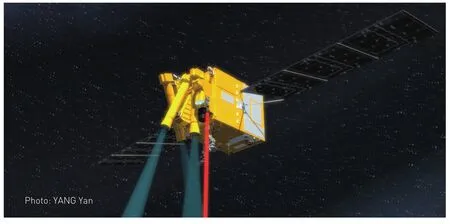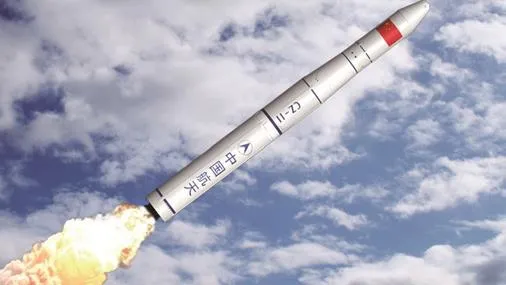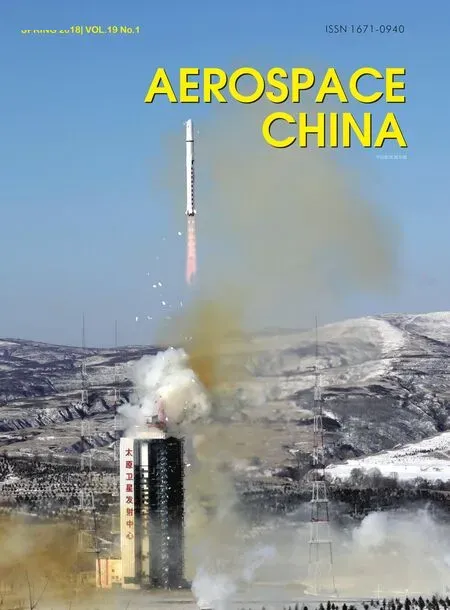Exploration of CASC’s Commercial Space
2018-02-20YANGBaohua
YANG Baohua
China Aerospace Science and Technology Corporation, Beijing 100048
Abstract: China’s commercial space activities started from the launch of Asiasat-1 satellite by a LM-3 launch vehicle on April 7, 1990. As the leading force in China’s space industry, CASC has been committed to commercial space for nearly 30 years. The article describes CASC’s advantages and activities in commercial space sector, as well as outlook for CASC commercial space development. The author concludes CASC is willing to coordinate and cooperate with state-owned and private companies and will create a new pattern for commercial space, opening up a new industry for space development and achieving more splendid achievement.
Key words: commercial launch services, commercial launch site solutions, low Earth orbit satellite constellation
1 SIGNIFICANCE OF DEVELOPING COMMERCIAL SPACE
On April 7, 1990, a LM-3 launch vehicle successfully launched the Asiasat-1 satellite into orbit, signifying the official entry of Chinese launch vehicles into the international launch service market and commencing the first year of China’s commercial space activities. Commercial space has played a critical role for years, advancing space technology, its applications and enabling the comprehensive development of China’s social economy.
Development of commercial space is an important way to implement national strategies and has become a major mission for the China Aerospace Science and Technology Corporation(CASC). CASC is the leading force in China’s space industry,shouldering strategic missions and taking the historical responsibility for building a cornerstone of security; exploiting the universe, promoting social and economic development; and leading the construction of an innovation-oriented nation. As a pioneer in area of commercial space in China, CASC has been committed to commercial space for nearly 30 years. In the coming era, CASC will continue to lead commercial space development in China and have a position in global business, thus enabling them to significantly accelerate the implementation of the Belt and Road Spatial Information Corridor construction.
To satisfy the market, further development of commercial space is inevitable. Some ambitious emerging commercial space business initiatives have attracted much attention and heated discussion. Considering the prosperity of the global space industry, the demand for commercial space market represented by commercial space launches, satellite applications, space tourism as well as other space technology spinoffs is dramatically increasing. With the background of globalization of the economy,science and technology, along with a highly developed commercial space sector must be one of the key criteria symbolizing international first-rate aerospace companies and space powers.
2 ADVANTAGES OF CASC IN DEVELOPING COMMERCIAL SPACE.
As a pioneer within China’s commercial space activities,CASC is the major spacecraft and launch vehicle manufacturer in China, a world well-known commercial launch service provider as well as the sole broadcast communication satellite operator in mainland China. CASC has achieved significant breakthroughs in multiple major engineering sectors thus bring benefit to ordinary citizens in their daily lives. A complete product system and technical capability has been established.
In the area of launch vehicles, we have 13 types of Long March series of launch vehicle products, enabling launches for all Earth orbits and interplanetary orbit. The launch capacity to low Earth orbit is up to 24 tons, and 14 tons into geosynchronous transfer orbit. The indexes of LM series of carrier rockets such as reliability, safety and orbit insertion accuracy have reached an international advanced level.
In terms of spacecraft, we have developed multiple families of satellite platforms, including the DFH series, ZY series, CAST series and SAST series for applications such as communications,remote sensing, navigation and scientific exploration.
The DFH series satellite common bus currently spans 6 members: DFH-3, DFH-4, DFH-4S, DFH-4E, DFH-4SP (allelectric) and DFH-5 with the full spectrum of products. The CASC in-orbit communications satellites cover geographical regions such as Asia, Europe, Africa, Oceania, the Indian Ocean and the Pacific Ocean, providing satellite communication services to regions providing communication for over 75% of the world’s population.
In the case of Earth observation satellites, CASC developed the ZY series, FY series, HY series, remote sensing series, small satellite constellations for environment and disaster monitoring and forecast and a high-resolution Earth observation series of satellites, which have been applied widely in the fields of land,ocean, mapping, environmental protection, civil affairs, meteorology, agriculture, forestry, water conservancy, earthquake,generation of transportation statistics, public security, energy and housing and urban-rural development, greatly improving the indigenous capability and helped to form a spatial information industrial network. We will meet the demand for more diverse refinement and improved timeliness in the future.

Figure 1 Artist’s concept of ZY-3 02 satellite
The BeiDou 2 satellite navigation and positioning system began providing service to the Asia Pacific region at the end of 2012 and has been widely used by services in the area of public security, transportation, disaster prevention and mitigation, agriculture, forestry and water conservancy, meteorology,land resources, environmental protection, police, mapping and exploration and for emergency rescue. A more integrated innovative satellite navigation service with higher accuracy will be marketed. The global BeiDou system will be established around 2020, proving all-weather, all-time positioning, navigation and timing services with high precision to customers globally, promoting the broad application of satellite navigation in all industries for the benefit of the national economy.
With regard technical capability, CASC has the full ability to develop, manufacture and testvarious kinds of spacecraft, launch vehicles and associated products, with over 40 variants of carrier rockets and more than 100 large, medium and small satellites clearing factory acceptance tests every year. The AIT centers,which have a total capability, are capable of conducting assembly and testing, mechanical environment, thermal vacuum, EMC,noise testing along with a compact range final test to completely cover all technologies and provide support facilities to enable the development of launch vehicles and spacecraft.
In addition, with the accumulated management experience with space projects, the management system for project R&D and production, quality and material logistics is gradually being completed. CASC’s rich experience in engineering management has become an important ability to support improved performance ability.
CASC has several business operation platforms and listed companies, providing the ability to move towards offering a diversified and a full range of commercial solutions. The system integrators represented by China Great Wall Industry Corporation (CGWIC), satellite operators represented by China Satellite Communications Co., Ltd. (China Satcom), APT Satellite Company Limited (APT Satellite) and China Siwei Surveying and Mapping Technology Co., Ltd. (China Survey) and product service providers represented by Chinarocket Co., Ltd. and China Spacesat Co., Ltd. have established platforms for marketing space products, services and various solutions. In addition, the China Innovation Fund and Sino Civil-Military Integration Fund set up by China Aerospace Investment Holdings Ltd. (CAH)supply quality financial platforms for the healthy development of commercial space.
3 CASC COMMERCIAL SPACE ACTIVITIES
As of October 2017, the LM series of launch vehicle had carried out 60 commercial launch services, including 14 piggyback services. International customers include those from 22 countries and regions, such as Nigeria, Brazil, Venezuela, Indonesia, France,Turkey, Bolivia, Laos and Belarus. CASC has established sound cooperation with world well-known aerospace manufacturers,satellite operators and space agencies. CASC completed 12 inorbit commercial satellite deliveries, of which 8 were commercial communications satellites and 2 were commercial remote sensing satellites exported to other countries and regions and 2 were domestic commercial remote sensing satellites.
CASC is capable of offering a full range of aerospace products, including solar wings, heat pipes and filters to support the growth of commercial space. The networking and operation of 4 SuperView-l commercial satellites with a 0.5 m-resolution will be achieved in 2018, enabling CASC to rank as one of the world-class satellite remote sensing operators. CASC is also able to undertake the construction of satellite AIT facilities and equipment and key ground facilities for satellite telecommunications and satellite remote sensing, including but not limited to satellite TT&C stations, remote sensing satellite ground stations,meteorological satellite command and data receiving stations,mobile remote sensing satellite ground receiving and processing stations for customers both at home and abroad.
With the capability of building a complete space technological application system, CASC has established various application systems serving the construction of the national economy utilizing a framework of remote sensing transmission, intelligence and application system.

Figure 2 Laosat-1 ground station
4 OUTLOOK FOR CASC COMMERCIAL SPACE DEVELOPMENT
CASC is able to offer rapid launch services using small launch vehicles into low Earth orbit at low cost. The LM-6 and LM-11 carrier rockets have the features of flexible launch and rapid response. The price of low Earth orbit launch per kilogram is expected to be reduced to US$ 5000 and the launch preparation period shortened to one week.
In addition, CASC can supply launch services to medium and high orbits with a launch capability to geosynchronous transfer orbit up to 7000 kg with a launch cost reduced to US$8000 - US$10000 per kilogram and for a 6000 kg payload into sun-synchronous orbit at US$ 5000 - US$ 6000 per kilogram.It only takes 10 days to prepare a launch of a medium carrier rocket to amedium high orbit.
To meet the demands of the commercial space launch market for lower cost and quick preparation, we are committed to providing various commercial launch site solutions including the new sea launch solution expected in 2018, establishing a specialized launch complex at the existing land-based launch centers as well as in the future establishing opportunities for low latitude commercial launches.
CASC will construct a low Earth orbit satellite constellation to provide Internet broadband services, upgrade and perfect high throughput communications satellite solutions and build commercial remote sensing satellite constellations as well. We are planning to open our spacecraft assembly, integration and testing (AIT) centers to international organizations, space agencies and research institutions and to all industrial sectors to support development of national commercial space and to serve international space cooperation.

Figure 3 A LM-6 launch vehicle is putting 3 Jilin-1 video satellites into orbit

Figure 4 Artist's concept of LM-11
5 CONCLUSION
Under the spirit of opening-up, inclusive development and sharing, CASC is willing to coordinate and cooperate with both state-owned and private companies from home and abroad,who are devoted to the peaceful use of space and for benefit of mankind, continuing innovation and co-development. While producing improved economic returns brought through technological achievements, we are committed to promoting social progress, improving mankind’s happiness. Facing the new opportunities with the global space industry, CASC will actively promote innovation, study and develop new strategies with new visions, new concepts and take part in the new system for space development, creating a new pattern for commercial space, opening up a new industry for space development and achieving more splendid achievements.
杂志排行
Aerospace China的其它文章
- China Sets Up Three Technical Approaches for Reusable Rocket Engine
- Yaogan 30-04 Set Satellites Launched
- CNSA Satellite Assembly Integration & Test Center Established
- Tiangong 1 Target Spacecraft Returned to Earth
- China to Build and Launch Cambodia’s First Communications Satellite
- China’s First High-Throughput Satellite Put into Operation
